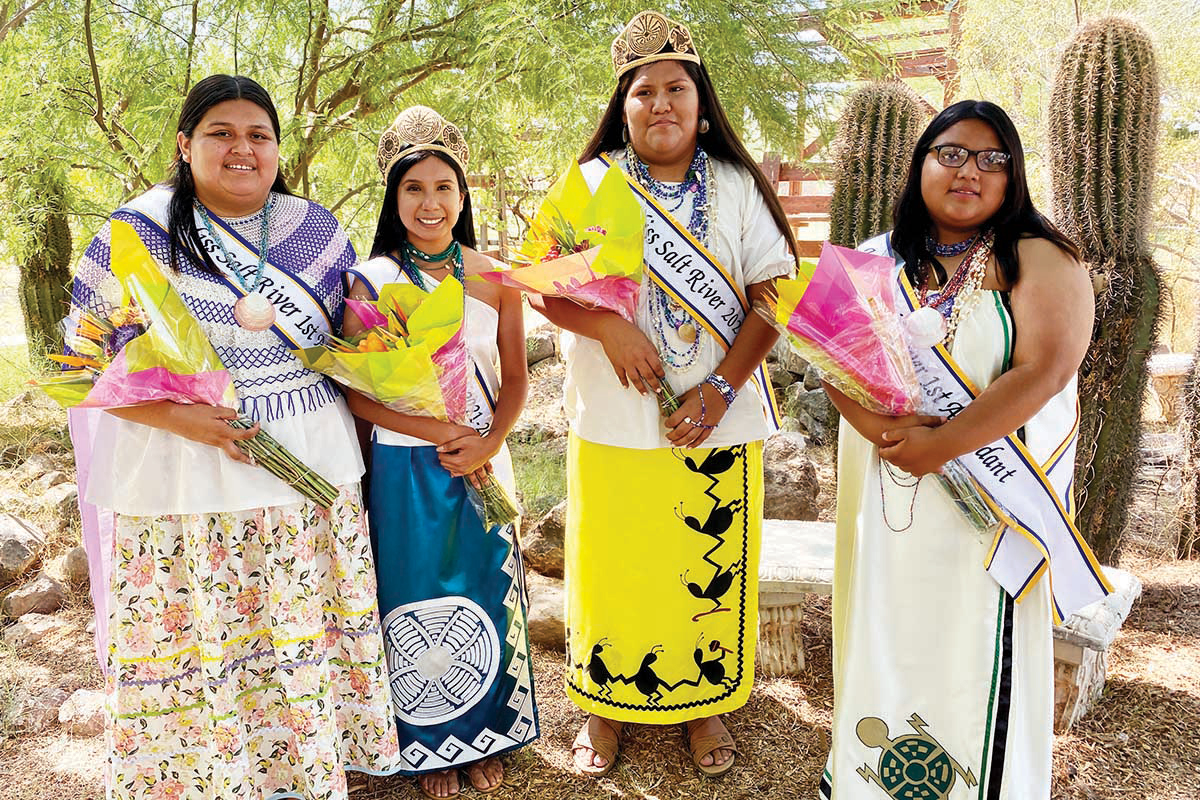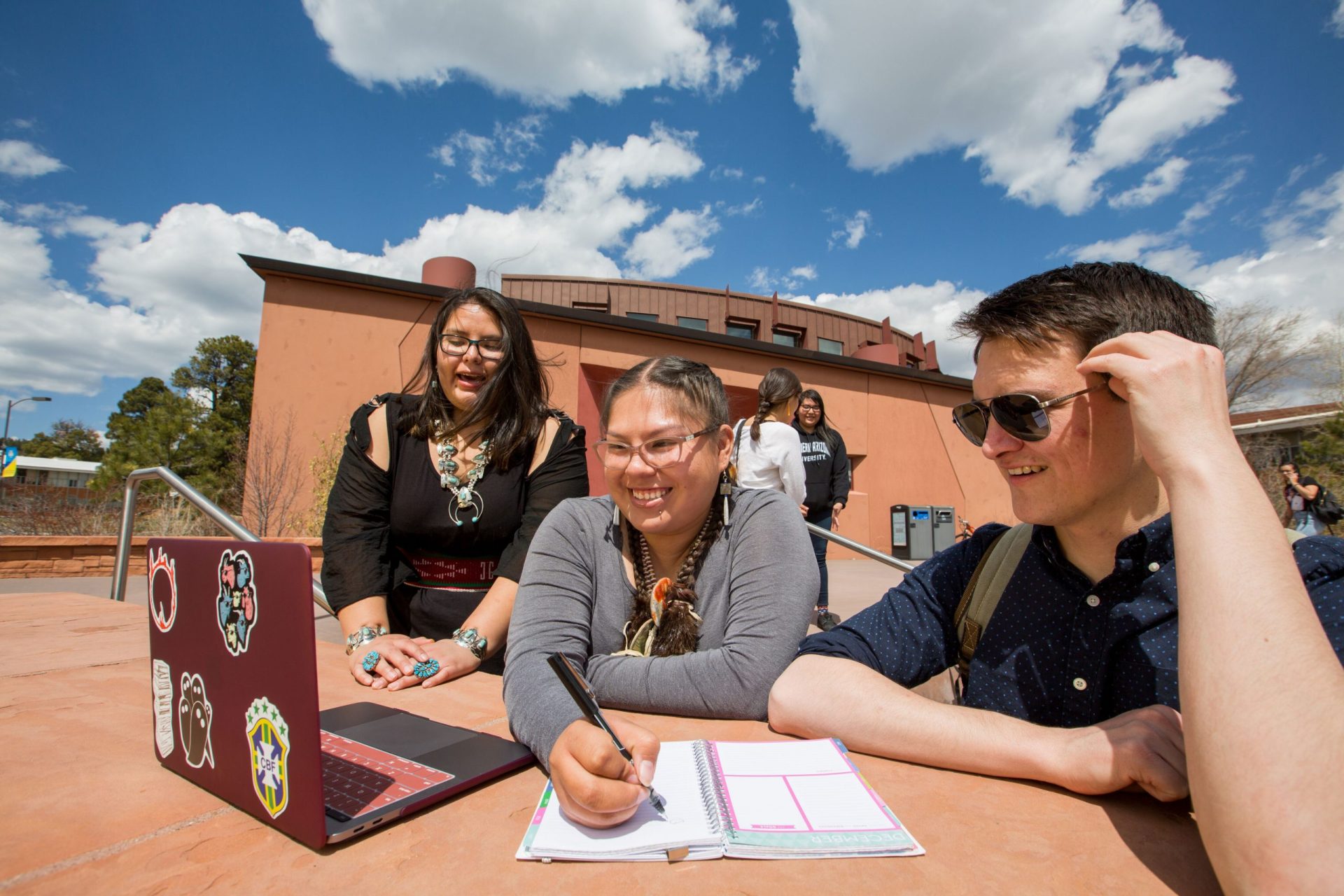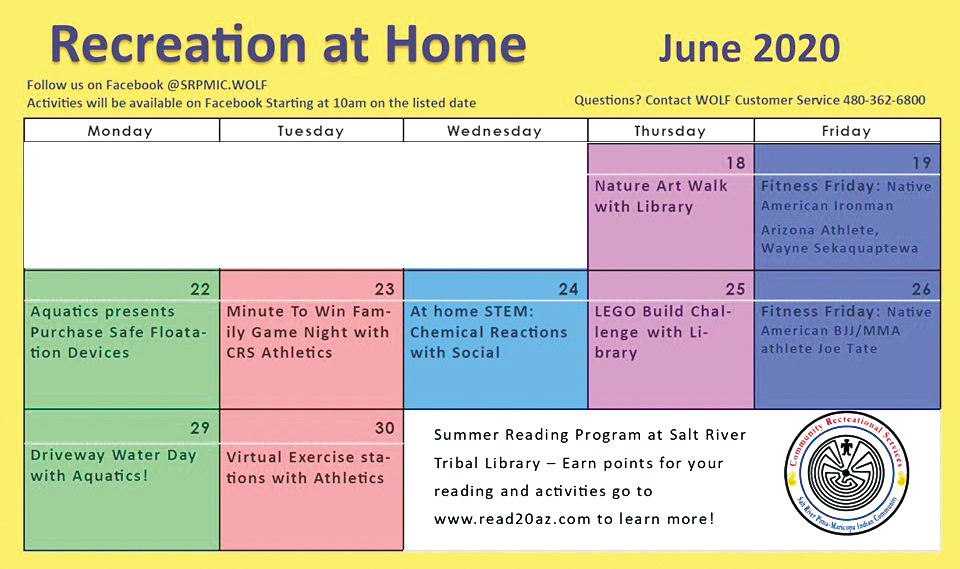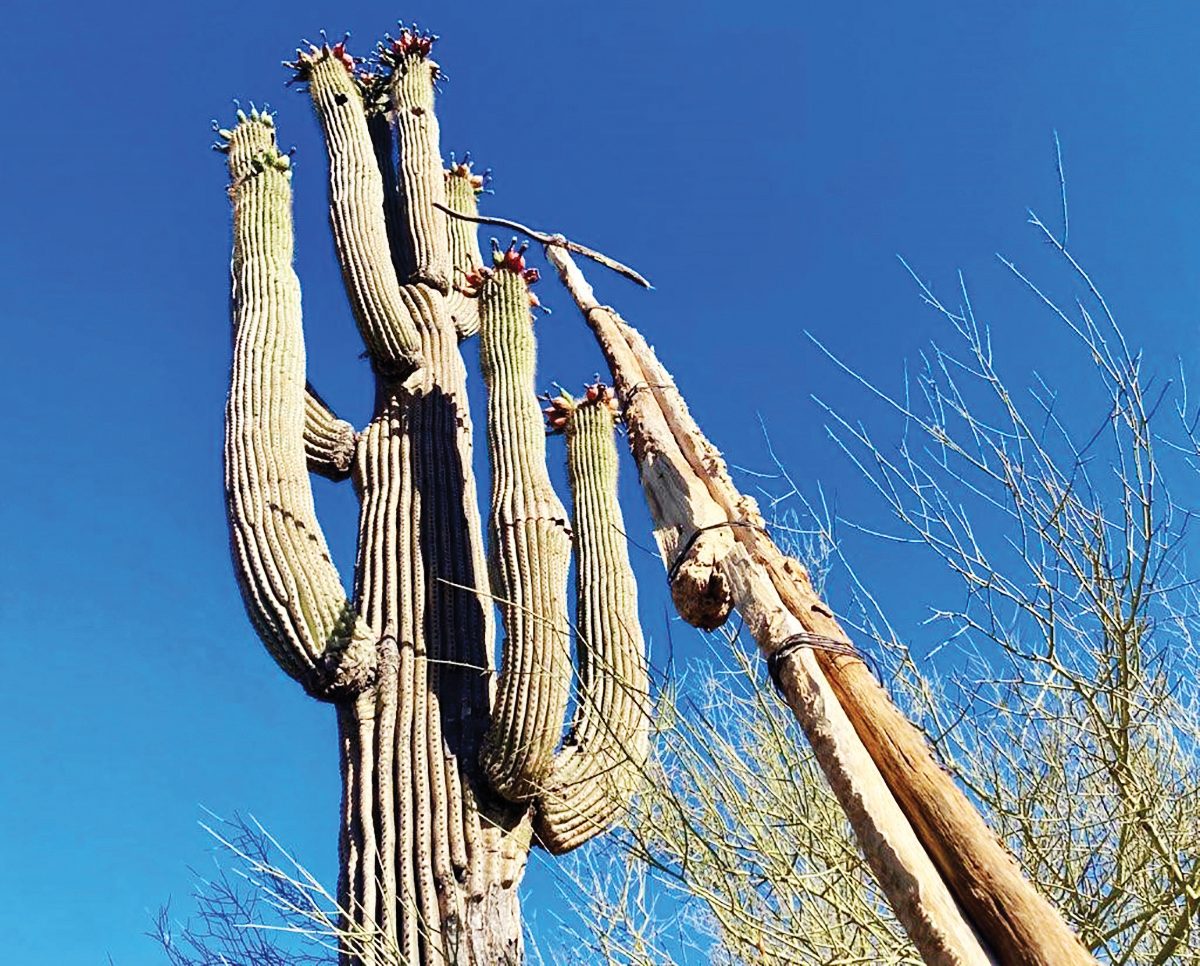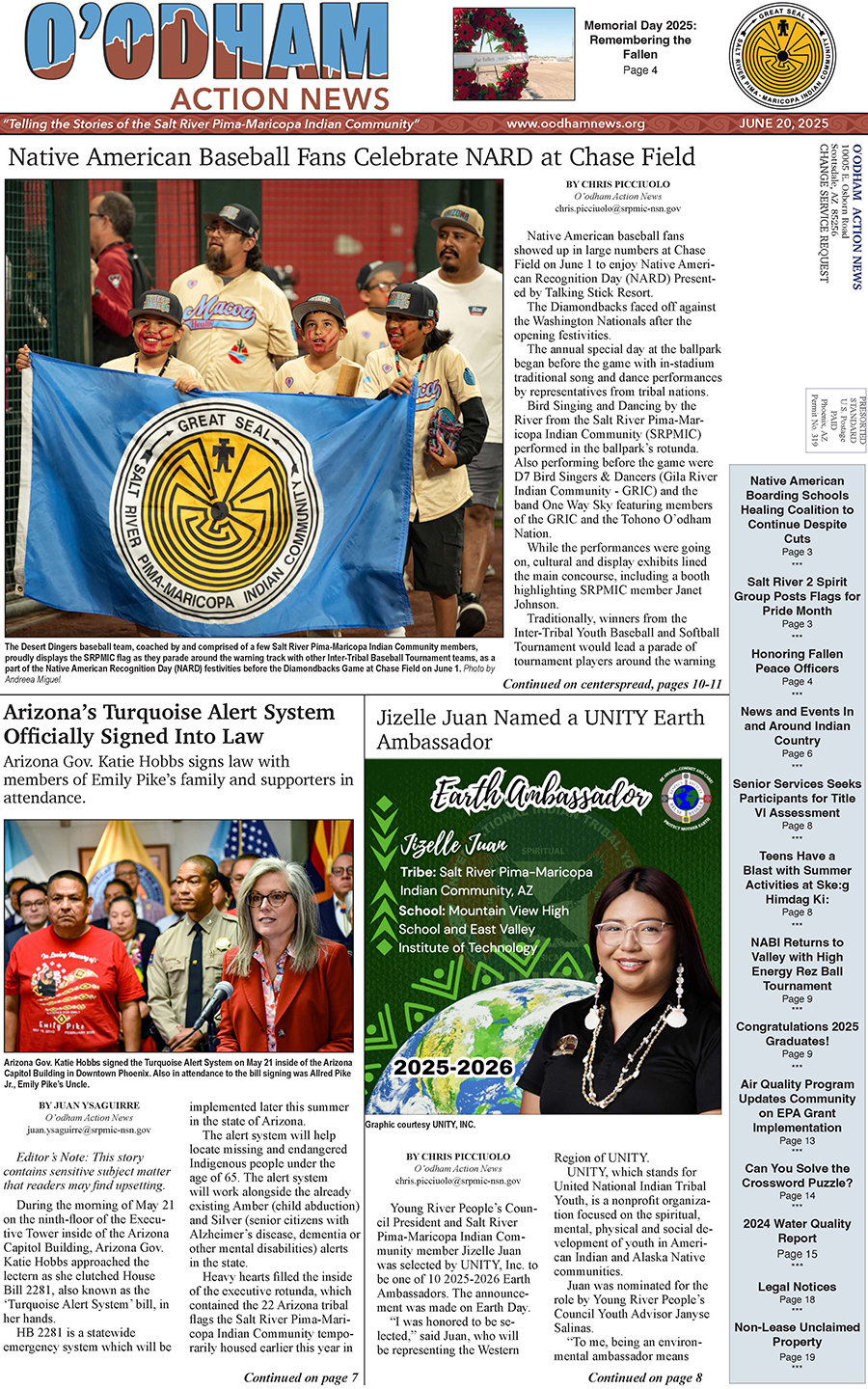VIEWS: 4341
July 1, 2021New SRPMIC Royalty Announced in a Virtual 2021-2022 Miss and Jr. Miss Salt River Pageant
The Salt River Pima-Maricopa Indian Community’s Jr. Miss and Miss Salt River pageants were held virtually this year, on June 17 and 18, respectively. The crowning ceremony was held on Saturday, June 19, and posted to the Community’s Vimeo. (To view the events, go online to www.srpmic-nsn.gov/community/msr/). This year’s pageant theme was “Integrating O’odham and Piipaash Values in the New Decade.”
Council Representative Cheryl Doka welcomed everyone to both pageants. She explained that the duty of the 2021-2022 Miss and Jr. Miss Salt River is to be a goodwill ambassador at various events inside and outside the Community.
Doka recalled the pageants when she was a teenager. “It was always an exciting time to see the young ladies participate in the pageant, and I was always in awe of how graceful and confident each participant was. Every young lady was unique in her own special way. For many, this is a dream or a goal they would like to achieve and have been preparing for, anticipating to share their culture, knowledge and personality with the Community. It is not easy participating in a pageant, so I applaud the participants for their strength, courage and positivity. I am so proud of them and know each one will do a good job.”
Rianna Tate sung the national anthem, and the invocation was given by 2020-2021 Red Mountain Eagle Powwow Princess La’Zensiah Vest. The master of ceremonies was Jacob Butler, SRPMIC member and Community Garden Coordinator for the Cultural Resources Department.
This year there were four new contestants, two in the Jr. Miss Salt River Pageant and two in the Miss Salt River Pageant.
Jr. Miss Salt River Pageant
“Tonight, two young ladies will demonstrate the knowledge they learned in preparation for today,” said Butler as he welcomed the Jr. Miss Pageant contestants.
The first contestant, Riana Cisneros, is the 14-year-old daughter of J’shon Medina and Ramon Cisneros. Her maternal grandparents are Yolonda Enos and Arthur Medina, and her paternal grandparents are Geraldine Carlos and Ramon Cisneros, Sr. . She currently attends Westwood High School and her hobbies are singing and dancing.
The second contestant, Robin Ramirez, is the 15-year-old daughter of Susan Three Irons and Elias Ramirez. Her maternal grandparents are Marilyn and Valerian Three Irons, and her paternal grandparents are Annette and Lynnwood Vest. In her free time, she likes to draw, listen to music and play video games; she also likes to play the violin.
Talent
Both contestants were given the opportunity to select a traditional or modern talent for their presentations. Cisneros demonstrated bird dancing with the help of singers Edward Pacer Reina and his son Hostiin Reina. Ramirez sang two verses of two traditional O’odham songs, “Black Cloud” and “The Going Home Song.” Prior to singing, she explained what each song meant.
Traditional Attire
Cisneros’ traditional wear was made by her grandmother, Annette Vest. She wore a purple satin Piipaash-style skirt with four ribbons that represent the four directions. Her blouse was a traditional cream-colored top adorned with a purple and white beaded cape.
Ramirez wore a two-piece O’odham dress with an off-white cotton top gathered on the front, back and on the sleeves. Her wraparound skirt was maroon and brown, made of cotton material with a black flowered print. The length is knee high for better walking and dancing. She wore a green scarf around her waist and a multicolored beaded necklace with shells that she made herself.
Essay
Contestants prepared essays addressing the pageant’s theme. “It is important to know where you come from. If you don’t know where you come from, you can ask your elders and it’s important to know about your tribe,” said Cisneros in her essay. “We grow up from learning and dancing, traveling to many different tribes and communities. I think it’s important for us to know what tribe and community we come from.”
“I think we can integrate our cultural values into the new decade by talking to our elders and listening to their stories,” said Ramirez in her essay. “When COVID-19 came into the Community, we lost many elders, storytellers, singers and family members. My family had to pray for strength to carry our grief and send our loved ones on their journey home. What this did for me was make me want to learn more about our language, Community and culture.
“We must remember that all of the songs and dances are not ours to keep, but they are ours to teach to the next generation to help them stay on track and to help our Himdak to continue.”
Miss Salt River Pageant
Contestant Nani Reina, 22, is the daughter of Pacer Reina and Nellie Silversmith-Reina. Her maternal grandparents are the late Merna Lewis and the late Jimmy Silversmith, and her paternal grandparents are Annette Rave Ortega and Edward Reina Jr.
Reina plans to study early childhood education at Scottsdale Community College in the fall. When she is not spending time with her family, she has found a passion in sewing O’odham and Piipaash skirts. Most of all she loves watching baseball; her favorite team is the Arizona Diamondbacks.
“I decided to run in the pageant as I see Miss Salt River as someone who is always welcoming and always educating people about who we are as people from Salt River,” said Reina.
Contestant Sistine Lewis, 19, is the daughter of Cecelia Andrews-Lewis and the late Newt Lewis. Her maternal grandparents are Corrine Antone and the late Manuel Andrews, and her paternal grandparents are Carmen Moore and the late Glenford Lewis Sr. and Jacob Moore.
Lewis is currently pursuing an associate degree in general studies at Scottsdale Community College. She plans to earn a bachelor of science in nursing and dreams of becoming a labor and delivery nurse. During her free time, she enjoys drawing and painting as well as spending time with her family, friends and dogs.
“My reason for participating in this year’s pageant is to be more involved with my Community, as well as learning more of my O’odham Himdak,” said Lewis.
Talent
Reina demonstrated sewing techniques she has learned, showing some skirts she has made and explaining the meaning behind each one.
“Recently I was taught by many different seamstresses from the Community many different sewing techniques, one of them being how to create Piipaash skirts,” said Reina. “I am not a pro; it took me many hours to finish one skirt, [but] through practice I have created many different skirts within a day.” She pointed out that one of her first skirts has its flaws, but through practice she was able to create better pieces.
“I am thankful for the seamstress who taught me how to create these dresses and the life lessons that I have learned along the way,” she said.
Lewis chose to perform the traditional O’odham dance called the swing dance and explain its meaning.
“Coyote was on top of a hill looking down and watching these kids dancing and having fun. He saw how much fun they were having and decided to run down the hill with the group. The kids didn’t know what to do so, they kept dancing and smiling at him,” said Lewis about the meaning behind the dance. “Unfortunately, Coyote had short legs, and the kids noticed how hard he was trying to keep up with them. They also felt bad because his tail was low and he kept slobbering all over himself. So the kids started dancing and stumbling to the right to help Coyote feel better, which is how the swing dance started.”
This is a social dance with two partners, but due to social distancing restrictions, Lewis demonstrated the dance alone.
Traditional Attire
Reina wore an O’odham-style dress from the early 1900s; due to the modesty laws of the time, Native women were forced to cover up from neck to ankles. Her dress was made of cotton with calico in a deep teal color. Her hair was covered with an unbleached muslin to keep it out of her face. Some might say the dress is plain and ugly, Reina explained, “but it’s a reminder of the hard-working women in our families and the support we have for one another.”
Lewis chose to wear a one-shoulder traditional-style dress composed of two pieces. For the top, she folded the material into a triangle and wrapped it around her chest and shoulder. The second piece was wrapped around the waist and tied at the hip to stay in place. She also wore a plaid apron around the waist. “The apron helps the woman as she tends to her daily chores, and she could place her apron in the river water to help cool her down during the hot summer,” she said. On her head she wore a traditional O’odham basket. She also wore a shell necklace to remind her of where she comes from.
Essay
In her essay, Reina addressed the difficulties imposed by the COVID-19 pandemic. She wrote, “Suddenly, everything came to a stop … and I struggled emotionally, spiritually and mentally. I quickly knew that 2020 was going to be one of the hardest trials I would be facing in my young life. …
“Like many others in the Community, my family experienced the loss of loved ones.” Reina recalled her time of isolation during her coming-out ceremony and how it taught her to prepare for life’s difficulties through discovering her cultural teachings and practices and trying to maintain a positive attitude.
Lewis wrote about the benefits of connecting with nature to help with physical and mental health issues. “For many decades our ancestors had to learn to provide for their families to stay alive and healthy. They walked this earth before us and gave us many traditions and values that we cherish today,” said Lewis in her essay. “As we come into a new decade that brings many changes, we as a Community must preserve our traditional values, connect with our Himdak as well as protect our wildlife, plants and families.”
Impromptu Questions
Finally, Miss Salt River contestants were judged on their unrehearsed responses to specially selected questions.
Asked about possible ways to help people struggling with addiction in the Community, Reina answered, “I think what we could do is to encourage them to get help. I have family members who struggle with drugs and alcohol, and it was a hard thing for them to realize they needed help. But they had courage and strength to overcome those trials and tribulations to be stronger people.”
Lewis was asked to name two places in the Community that are important to her and why. She answered, “One is our beautiful river, because our ancestors were there and they beautified our land …. It’s very beautiful now with all the greenery, and especially now we can get in the water and swim during the hot summers,” said Lewis. “The other place that is beautiful to me is the Two Waters Building, because [you have] everything right there—the Huhugam Ki Museum, cafeteria, all the [government] buildings—and you get to see everyone there, not just one person but a mixture of all kinds of people.”
Judging and Crowning
This year’s pageant judges were SRPMIC Director of Administration Glen Law, Salt River Education family advocate Pamela Prasher and Colorado River Indian Tribes Mohave member Denise Homer.
The invocation was given by 2003-2004 Miss Salt River Aristina Sanchez, and Butler continued as master of ceremonies. Miss Salt River 1968-1969 Darayne Achin, currently an associate judge for the SRPMIC, gave a few remarks prior to the crowning. The outgoing Miss and Jr. Miss Salt River, Isabella Dockerty and Marisela Villegas, also give farewell addresses.
Awards: Jr. Miss Salt River
The Miss Congeniality award goes to the contestant who exhibits a friendly and personable attitude, is sociable and is always willing to assist others in an unselfish manner. The winner was Riana Cisneros, who received artwork created by Community artist Dwayne Manuel.
The Talent Award goes to the contestant who displayed creativity, artistic aptitude and an outstanding talent performance. The winner was Robin Ramirez. She received a clay pot made by Community artist August Wood.
The Essay Award went to Ramirez, who also received the Traditional Dress award.
Cisneros was named First Attendant. She received a sash and flowers, plus a shawl, a scarf, a shell necklace, a gourd trophy, a tripod ring light and a beaded necklace. In the event the new Jr. Miss Salt River is unable to fulfill her duties, the First Attendant shall take over the reign.
The 2021-2022 Jr. Miss Salt River title went to Robin Ramirez. She received the crown, sash and flowers, plus a shawl, a scarf, a shell necklace, a hat box, a Surface Pro laptop, a luggage set, a beaded cape, a beaded necklace, a gourd trophy and a $1,200 monetary award.
Awards: Miss Salt River
Sistine Lewis was named Miss Congeniality and received artwork created by Community artist Dwayne Manuel.
The Talent Award was presented to Nani Reina, who received a clay pot made by Community artist August Wood.
The Essay and Traditional Dress awards went to Lewis.
Reina was named First Attendant. She received a sash and flowers, a shawl, a scarf, a shell necklace, a gourd trophy, a tripod ring light and a beaded necklace. If the new Miss Salt River cannot fulfill her duties, the First Attendant shall take over the reign.
The new 2021-2022 Miss Salt River title went to Sistine Lewis. She received the crown, sash and flowers, plus a shawl, a scarf, a shell necklace, a hat box, a Surface Pro laptop, a luggage set, a beaded cape, a beaded necklace, a gourd trophy and a $1,800 monetary award.

